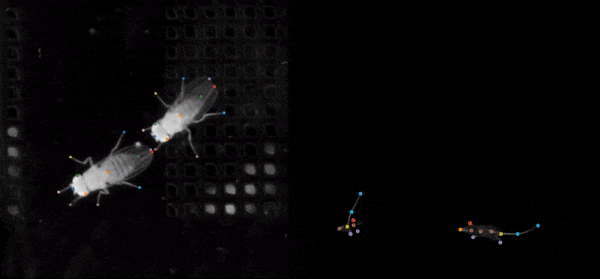SLEAP is an open source deep-learning based framework for estimating positions of animal body parts. It supports multi-animal pose estimation and tracking, and includes an advanced labeling/training GUI for active learning and proofreading.
SLEAP is written in Python and uses TensorFlow 2 for machine learning and Qt/PySide2 for graphical user interface. SLEAP is the successor to LEAP (Pereira et al., Nature Methods, 2019).
- Purpose-built GUI and human-in-the-loop workflow for rapidly labeling large datasets
- Multi-animal pose estimation with top-down and bottom-up training strategies
- State-of-the-art pretrained and customizable neural network architectures that deliver accurate predictions with very few labels
- Fast training: 15 to 60 mins on a single GPU for a typical dataset
- Fast inference: 400+ FPS for batch, 10ms latency for realtime
- Support for remote training/inference workflow (for using SLEAP without GPUs)
- Flexible developer API for building integrated apps and customization
To get started with SLEAP, head over to the Documentation where you'll find tutorials, guides and example notebooks.
To learn more about the technical side of SLEAP and multi-animal pose tracking, check out our preprint on bioRxiv or watch the tutorial on SLEAP. For a more general introduction to the field of quantitative animal behavior, check out our review in Nature Neuroscience.
You can find the latest version of SLEAP in the Releases page.
If you use SLEAP in your research, please cite:
Talmo D. Pereira, Nathaniel Tabris, Junyu Li, Shruthi Ravindranath, Eleni S. Papadoyannis, Z. Yan Wang, David M. Turner, et al. 2020. "SLEAP: Multi-Animal Pose Tracking." bioRxiv. https://doi.org/10.1101/2020.08.31.276246.
SLEAP is released under a Clear BSD License and is intended for research/academic use only. For commercial use, please contact: Laurie Tzodikov (Assistant Director, Office of Technology Licensing), Princeton University, 609-258-7256.
Follow @MurthyLab on Twitter for news and updates!
Technical issue with the software? Open an issue on GitHub.
Press inquiries? Interested in using SLEAP in a commercial application? Reach out at sleap@princeton.edu.
- Talmo Pereira, Princeton Neuroscience Institute, Princeton University
- Arie Matsliah, Princeton Neuroscience Institute, Princeton University
- Nat Tabris, Princeton Neuroscience Institute, Princeton University
- David Turner, Research Computing and Princeton Neuroscience Institute, Princeton University
- Joshua Shaevitz, Physics and Lewis-Sigler Institute, Princeton University
- Mala Murthy, Princeton Neuroscience Institute, Princeton University
SLEAP is developed in the Murthy and Shaevitz labs at the Princeton Neuroscience Institute at Princeton University. This work was made possible through our funding sources, including: NIH BRAIN Initiative R01 NS104899 and Princeton Innovation Accelerator Fund.




